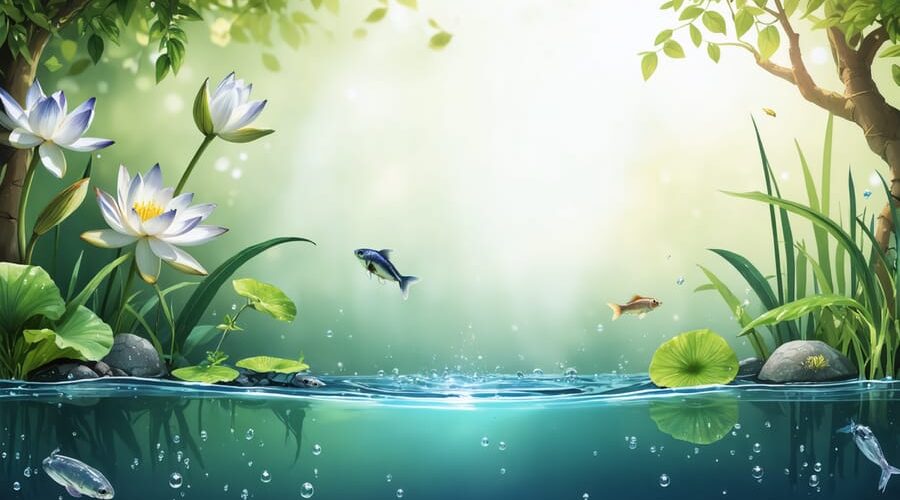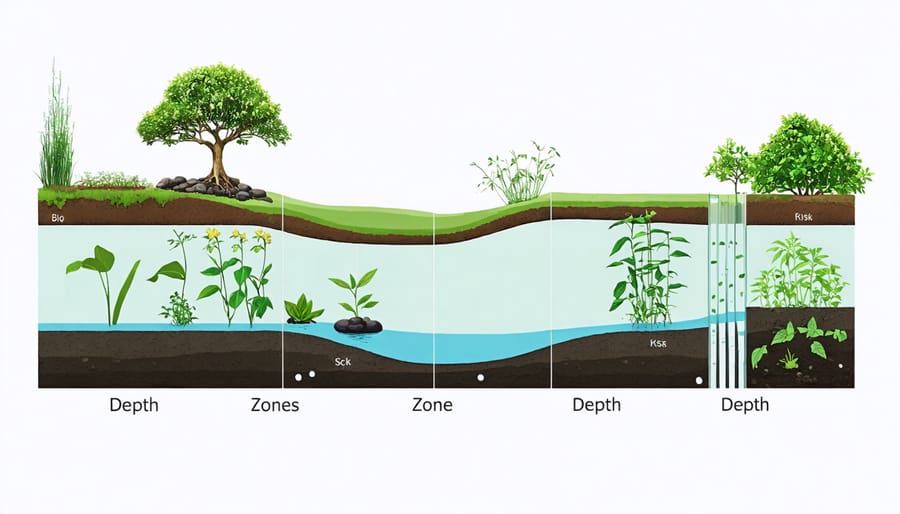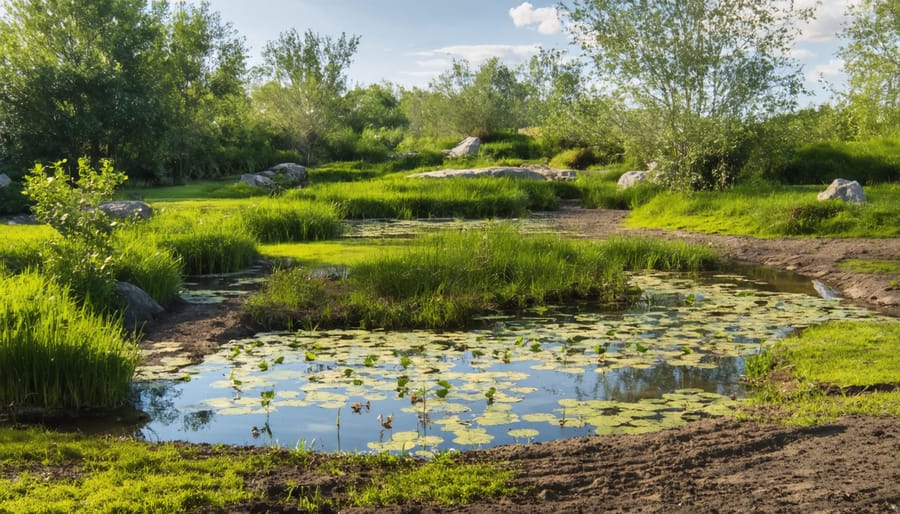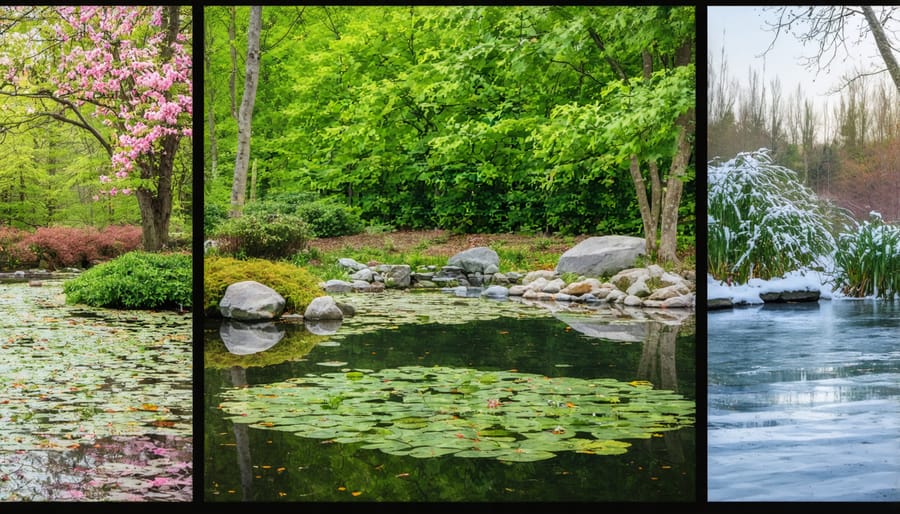
Bio Ponds: Create a Self-Sustaining Water Paradise in Your Backyard
Transform your backyard into a thriving pond ecosystem that practically maintains itself. Bio ponds harness nature’s own filtering systems, creating a self-sustaining water feature that brings life and tranquility to any outdoor space. By combining carefully selected aquatic plants, beneficial bacteria, and the right balance of fish, these natural swimming pools and water gardens work in perfect harmony without chemical interventions.
Unlike traditional water features that demand constant maintenance and artificial treatments, bio ponds mimic natural wetland environments. Native plants act as living filters, absorbing excess nutrients while providing shelter for beneficial microorganisms. Fish contribute to the ecosystem by controlling insect populations and producing nutrients for plant growth. The result? A crystal-clear, chemical-free pond that enhances your property’s biodiversity while requiring minimal upkeep.
Whether you’re planning a serene meditation spot, a natural swimming area, or a vibrant wildlife habitat, bio ponds offer an eco-friendly solution that connects you directly with nature. Let’s explore how to create and maintain these remarkable aquatic ecosystems in your own backyard.
The Natural Balance of Bio Ponds
Plants That Power Your Pond
A thriving bio pond depends on carefully selected essential aquatic plants that work together to maintain crystal-clear water. Start with oxygenating plants like Hornwort or Elodea, which release oxygen and absorb excess nutrients beneath the surface. These underwater workhorses help prevent algae growth and keep your pond breathing.
Float some Water Lilies or Lotus on the surface – they’re not just pretty faces! These plants shade the water, reducing algae growth while providing shelter for pond life. Along the edges, marginal plants like Iris and Rush create a natural transition from water to land while filtering out pollutants through their roots.
Don’t forget about submerged plants like Vallisneria, which provide spawning areas for fish and help maintain water clarity. For the best results, aim to cover about 60% of your pond’s surface with a mix of these different plant types. Remember to start with a few varieties and gradually add more as your pond ecosystem develops.
Beneficial Bacteria and Microorganisms
Just like a tiny city beneath the surface, your bio pond is home to millions of beneficial bacteria and microorganisms that work tirelessly to maintain water quality. These microscopic helpers break down waste, convert harmful substances into harmless ones, and keep your pond naturally balanced.
The most important bacteria are the nitrifying bacteria, which transform toxic ammonia from fish waste into less harmful nitrites, and then into safe nitrates that plants can use as fertilizer. Think of them as nature’s cleanup crew! Other helpful microorganisms include beneficial algae that produce oxygen during daylight hours and various decomposing bacteria that break down fallen leaves and organic matter.
To help these invisible heroes thrive, avoid using harsh chemicals in your pond and provide plenty of surface area for them to colonize through rocks, gravel, and biological filter media. It takes about 4-6 weeks for a healthy bacterial colony to establish itself in a new pond, so be patient during this crucial settling period. Remember, these tiny organisms are the foundation of your pond’s ecosystem, working 24/7 to keep your water crystal clear and your fish healthy.
Setting Up Your Bio Pond for Success
Choosing the Perfect Location
Selecting the right spot for your bio pond is crucial for its long-term success and enjoyment. Start by finding a relatively level area that receives partial sunlight – about 4-6 hours daily is ideal. Too much sun can lead to excessive algae growth, while too little might limit plant diversity.
Consider the natural contours of your land, as you can use slopes to your advantage for creating waterfalls or streams. However, avoid placing your pond at the lowest point of your yard, where runoff from rain could introduce unwanted chemicals or debris.
Keep trees at a reasonable distance to prevent falling leaves from overwhelming your pond’s ecosystem, though a bit of shade from smaller trees or shrubs can be beneficial. Think about viewing angles too – where will you most often see your pond from? Your patio, kitchen window, or favorite garden spot?
Accessibility is another key factor. You’ll want easy access for maintenance and to simply enjoy your pond. Also, check local regulations and utilities before breaking ground – ensuring you’re not digging where pipes or cables run.

Essential Zones and Depths
A successful bio pond relies on different zones that work together to create a thriving ecosystem. Think of these zones as neighborhoods, each playing a vital role in maintaining the pond’s natural balance.
The shallow marsh zone, typically 2-8 inches deep, sits at the pond’s edge. This area hosts marginal plants like rushes and iris, which help filter water and provide shelter for small wildlife. It’s also where beneficial bacteria thrive, breaking down waste and keeping water clean.
Moving deeper, you’ll find the medium depth zone (8-16 inches). This area is perfect for submerged plants like water lilies, which add beauty while providing shade and oxygen. The shade helps prevent excessive algae growth and keeps water temperatures stable during hot summer days.
The deep zone, usually 2-3 feet, is essential for pond stability. It offers fish a safe retreat during extreme weather and helps maintain consistent water temperatures. This zone also provides space for bottom-dwelling plants and creates a thermal mass that prevents the pond from freezing solid in winter.
Between these main zones, create gentle slopes rather than steep drops. This natural transition helps prevent erosion and makes it easier for wildlife to enter and exit safely. For the best results, aim to make about 50% of your pond area shallow zones, 30% medium depth, and 20% deep water.
Remember, these zones don’t need strict boundaries – nature loves gentle transitions. The key is creating variety in your pond’s depth to support different types of life and maintain a healthy, balanced ecosystem.
Filtration Without the Fuss
One of the most appealing aspects of bio ponds is their reliance on natural filtration methods rather than complex mechanical systems. Unlike traditional ponds that depend on expensive pumps and filters, bio ponds use a carefully planned ecosystem to keep the water crystal clear.
The secret lies in the plant zones and beneficial bacteria that work together to process nutrients and maintain water quality. A well-designed bio pond typically needs only a small circulation pump to keep water moving gently through the system. The plants do most of the heavy lifting – aquatic vegetation absorbs excess nutrients, while special filtration plants trap sediment and provide homes for beneficial microorganisms.
You won’t need to invest in costly UV clarifiers or chemical treatments. Instead, focus on creating the right balance of plants: deep-water aquatics, marginals, and oxygenators. A layer of gravel or special bio-media in designated areas provides additional surface area for beneficial bacteria to colonize.
The best part? This natural approach means less maintenance for you. Regular pruning of plants and occasional debris removal are usually all that’s needed to keep your bio pond thriving. It’s amazing how nature does most of the work when you set up the right conditions!

Maintaining Your Bio Pond Naturally
Seasonal Care Calendar
Keeping your bio pond healthy requires different care routines throughout the year. Let’s break down the essential tasks by season to help you maintain a thriving ecosystem.
Spring (March-May):
Remove debris that accumulated over winter and trim back dead plant material. Test water quality and perform a partial water change if needed. Start feeding fish gradually as temperatures rise above 50°F (10°C). Add beneficial bacteria to jumpstart the biological filtration system.
Summer (June-August):
Monitor water levels regularly and top up during dry spells, using rainwater when possible. Trim aquatic plants to prevent overgrowth and remove any algae build-up. Keep an eye on water temperature and provide shade if needed. Continue regular feeding of fish and check filter systems monthly.
Fall (September-November):
Remove fallen leaves before they sink and decay. Trim back marginal plants and remove tropical species before first frost. Reduce fish feeding as temperatures drop. Install pond netting to catch falling leaves and protect from predators.
Winter (December-February):
Keep a small area free from ice for gas exchange – never break ice directly as this can harm fish. Remove snow from pond covers to allow light penetration. Stop feeding fish when temperatures consistently drop below 50°F (10°C). Check equipment occasionally but minimize disturbance to the pond’s winter rest.
Year-round tasks include monitoring water quality, checking pump and filter operation, and observing fish and plants for signs of stress or disease. Remember that these guidelines may need adjustment based on your local climate and specific pond conditions.

Common Issues and Natural Solutions
Every bio pond owner faces challenges, but nature often provides the best solutions. One common issue is excessive algae growth, which can be naturally controlled by adding more floating plants like water lilies or duckweed. These plants compete with algae for nutrients and provide shade, naturally keeping the green stuff in check.
Murky water is another frequent concern. Instead of reaching for chemical clarifiers, try adding more submerged plants like hornwort or installing a small waterfall. These natural solutions increase oxygen levels and help beneficial bacteria thrive, resulting in clearer water.
If you’re dealing with mosquito problems, consider introducing mosquito-eating fish like gambusia or adding a small fountain to keep the water moving. Mosquitoes can’t lay eggs in moving water, making this a simple yet effective solution.
Sometimes, you might notice an imbalance in your pond’s ecosystem, leading to fish stress or plant deterioration. Adding beneficial bacteria through natural pond starter cultures can help restore balance. You can also encourage these good bacteria by incorporating rock clusters and gravel zones in your pond design.
Falling leaves can cause water quality issues, especially in autumn. Rather than using chemical treatments, install a simple net over your pond during leaf-falling season, or create a natural filtration zone using aquatic plants like cattails and rushes.
Remember that a bio pond is a living ecosystem that sometimes needs time to find its balance. Patience is often the best approach, as most issues will resolve themselves naturally if you’ve created a diverse and well-planned environment.
Wildlife Integration
A bio pond isn’t just a water feature – it’s a vibrant ecosystem that can become a sanctuary for local wildlife. Attracting beneficial wildlife to your pond creates a natural balance that helps maintain water quality and adds life to your garden.
Start by incorporating different water depths – shallow areas attract birds and insects, while deeper zones provide safe havens for fish and amphibians. Native aquatic plants are essential, offering natural shelter and breeding spots for various creatures. Consider adding partially submerged logs or rocks around the edges, creating perfect sunbathing spots for dragonflies and landing pads for birds.
To welcome friendly visitors, avoid using harsh chemicals that might harm delicate ecosystems. Instead, let nature take its course – frogs and dragonflies will help control mosquito populations, while birds keep unwanted insects in check. Water beetles and snails work as natural cleaners, consuming algae and debris.
Remember to maintain some wild areas around your pond with native flowers and grasses. These create corridors for wildlife to move safely between habitats. Consider adding a shallow beach area where animals can easily enter and exit the water. During winter, keep a small area free from ice to ensure wildlife can access the water year-round.
With patience, you’ll see your bio pond transform into a thriving habitat that supports local biodiversity while requiring minimal maintenance from you.
Creating a bio pond is more than just adding a water feature to your outdoor space – it’s about fostering a thriving ecosystem that brings life, beauty, and natural balance to your garden. As we’ve explored throughout this guide, bio ponds offer numerous benefits that make them an attractive option for any homeowner or gardening enthusiast.
From providing a habitat for beneficial wildlife to creating a stunning focal point in your landscape, bio ponds deliver both practical and aesthetic value. The self-sustaining nature of these ecosystems means less maintenance work for you, while the natural filtration processes ensure clean, clear water without relying heavily on chemicals or expensive equipment.
Whether you’re an experienced gardener or just starting your outdoor journey, creating a bio pond is an achievable project that can bring years of enjoyment. The initial investment in proper planning and setup will reward you with a dynamic, living water feature that evolves and improves with time.
Ready to start your bio pond adventure? Remember to take it step by step, focusing on creating proper layers and zones, selecting appropriate plants, and maintaining the right balance of elements. Don’t be afraid to start small – even a modest bio pond can create a significant impact on your garden’s ecosystem.
Join the growing community of bio pond enthusiasts and discover the joy of watching your aquatic ecosystem flourish. Your garden’s new natural oasis awaits!
